Originally Posted At: https://breakingmuscle.com/feed/rss
Maybe you first saw the pullover performed in low-res videos of Golden-era bodybuilders. Now, it’s common to see in commercial fitness centers, rehabilitation facilities, and home gyms. The dumbbell pullover is a classic back and chest exercise that’s experiencing a renaissance — and for good reasons.
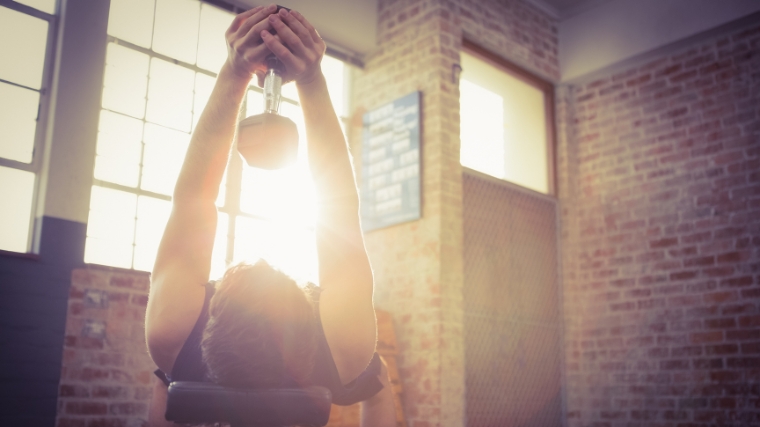
This guide covers step-by-step instructions, benefits, unique considerations, variations, and programming for the dumbbell pullover.
Dumbbell Pullover
- How to Do the Dumbbell Pullover
- Dumbbell Pullover Mistakes to Avoid
- How to Progress the Dumbbell Pullover
- Benefits of the Dumbbell Pullover
- Muscles Worked by the Dumbbell Pullover
- How to Program the Dumbbell Pullover
- Dumbbell Pullover Variations
- Frequently Asked Questions
Dumbbell Pullover Instructional Video
Here’s Dr. Merrick Lincoln instructing the traditional form for the dumbbell pullover. Review the form and hear specific tips before practicing the movement on your own.
How to Do the Dumbbell Pullover Step By Step
The dumbbell pullover is an overhead shoulder extension exercise performed lying on a bench. These step-by-step instructions ensure proper form.
Step 1 — Set Up a Strong Foundation
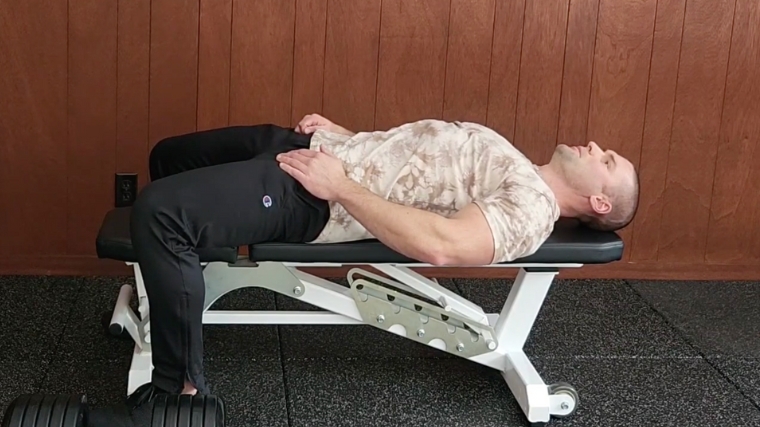
For the traditional dumbbell pullover, five stable points of contact are required — The back of your head, shoulder blades, and glutes must remain in contact with the bench, and both feet must be touching the floor. If your bench is too tall, placing your feet on the bench frame or atop weight plates is acceptable.
Form Tip: Position your head as far up the bench as possible. By placing your head high on the bench, you reduce the likelihood of the bench impeding shoulder range of motion during the pullover.
Step 2 — Retrieve Your Dumbbell and Brace
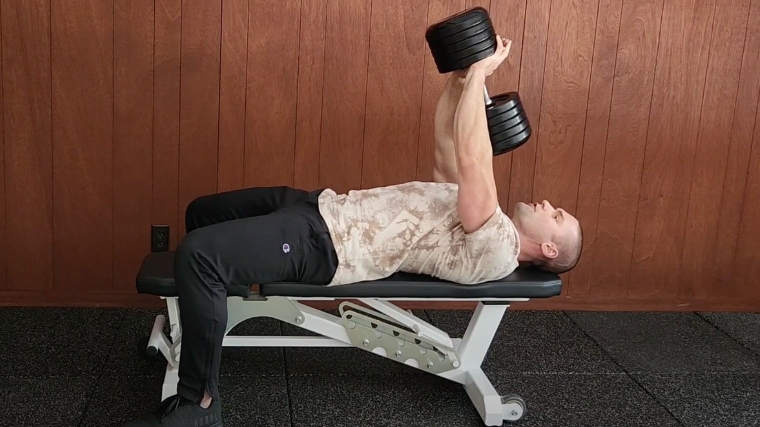
The pullover requires a spotter due to movement of the dumbbell over your face and head. A spotter is an individual who assists with the movement and provides physical assistance in the event of form breakdown or failure.
A spotter is also helpful, because they can pass you the dumbbell when you are ready to begin. Otherwise, you will need to transfer the dumbbell from atop your thigh to above your chest, which can be awkward positioning. Whether or not you choose to recruit a spotter, you will cradle the inside top half of the dumbbell in your palms with thumbs and fingers wrapped around the handle.
Form Tip: Grasp the dumbbell securely before bringing it over your face or before giving your spotter the signal to release it. The handle of the dumbbell should sit between the base of your thumbs and body of the hands. With one palm on each side of the dumbbell, create a “closed” grasp by overlapping your thumbs behind the handle and overlapping fingers in front.
Step 3 — Lower to the Bottom Position
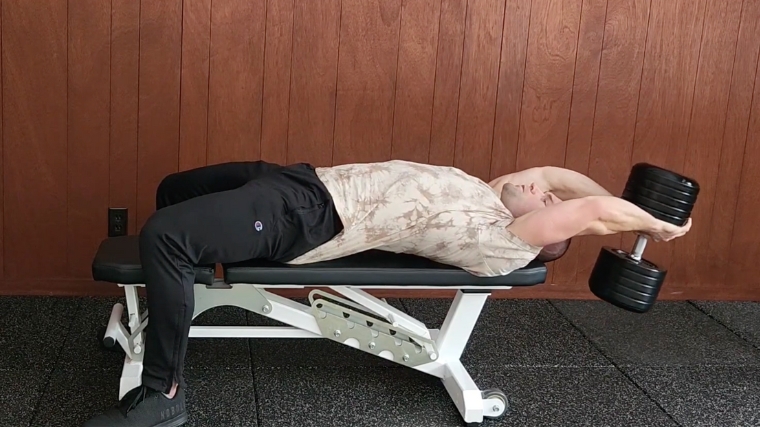
Begin with dumbbell above your upper chest with your arms vertical and elbows unlocked or slightly bent. Brace your abdominal muscles and maintain the five points of contact with the bench and the floor. Lower the dumbbell toward the floor with control. End the downward movement when you reach the greatest amount of shoulder flexion (stretch) that you can tolerate and control.
Form Tip: Achieve a tolerable stretch across your shoulders at the bottom position. The goal is to move through your full available range of overhead motion, not simply bringing the weight as close to the ground as possible.
Step 4 — Raise to the Top Position
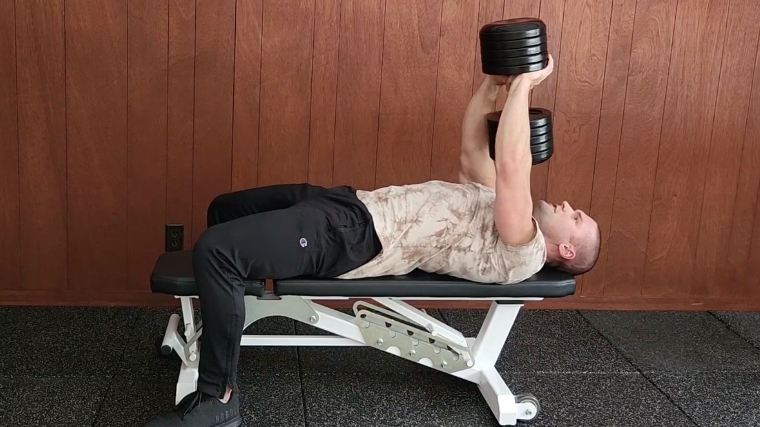
Reverse the movement by pulling the dumbbell through the same arc of movement. The repetition is complete when your upper arms are vertical. Keep your head locked in neutral and your gaze directed at the ceiling — don’t follow the weight with your eyes or head. Allowing your head to tilt into extension (looking overhead) promotes undesirable extension throughout the entire spine.
Form Tip: Maintain the same degree of arm bend throughout each repetition. If your elbows are bending and straightening during the exercise, you’re shifting muscular stress away from your chest and back and onto your triceps.
Step 5 — End the Set Safely
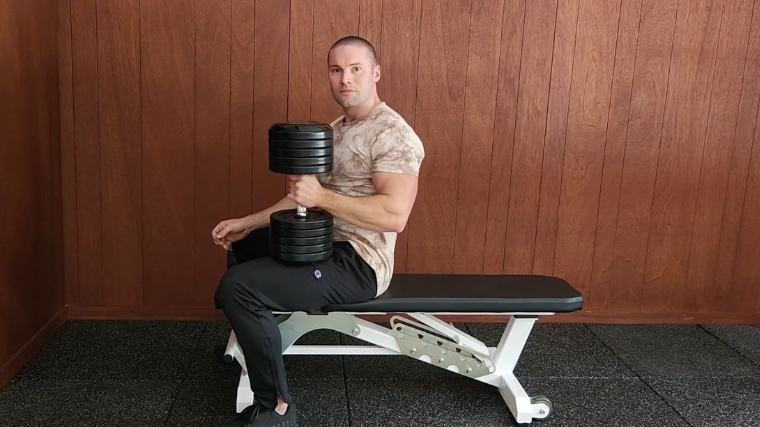
If you are using a spotter (recommended), indicate the set is complete. The spotter should take the dumbbell with both hands. (1) If you are training solo (at your own risk), bring the dumbbell to your thigh.
Form Tip: Avoid dropping the dumbbell on your face or chest. Unless you’re itching for a visit to the hospital and likely plastic surgery, safety is priority number one. Ensure the spotter has full control of the dumbbell before you let go. If training alone, maintain a secure grip until the dumbbell rests on your thigh.
Dumbbell Pullover Mistakes to Avoid
The pullover appears simple and sounds self-explanatory — Lie on your back and “pull the dumbbell over,” right? Well, yes, but a plethora of technique faults plague this exercise. Avoiding these errors to improve the effectiveness and safety of the dumbbell pullover.
Excessive Elbow Bend and “Flaring”
During the traditional dumbbell pullover, slight elbow bend allows the lifter to hold the dumbbell while moving their upper arms in the sagittal plane (i.e. parallel to the body’s midline). When lifters allow excessive elbow bend, the difficulty of the pullover is reduced, because the dumbbell is now closer to your shoulders.
More often than not, excessive elbow bend is also associated with “flared,” or outward-pointing, elbows. This position reflects internal rotation of the shoulder and may increase stress on the inside of the elbow (i.e. ulnar collateral ligament stress) during the pullover.
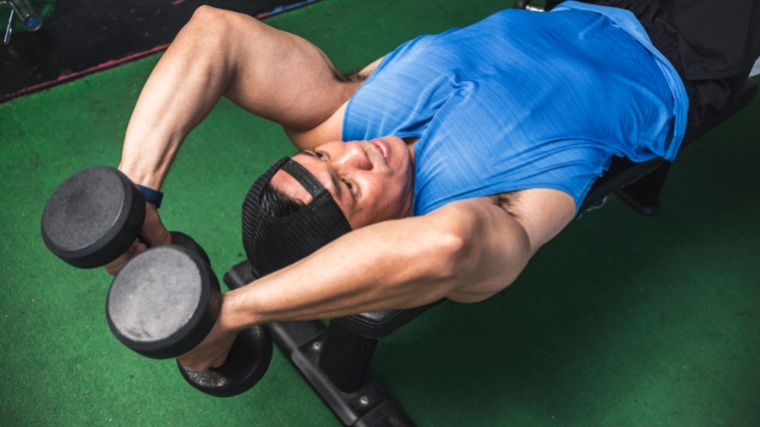
Avoid it: Focus on keeping your elbows pointing forward and/or up during the dumbbell pullover. While elbows should always remain “unlocked,” the pullover should never feel like a triceps extension (“skull crusher”).
Losing Contact with the Bench
Although allowing your hips to rise from the bench may give the impression of increased range of motion, back and hip extension does not equate to shoulder mobility. Unlike a competition-style bench press, arching is counterproductive to the pullover because it ultimately removes tension from latissimus dorsi. (2)
Worse still, excessive arching may allow a heavy dumbbell to destabilize your position, which could result in a “glutes over dumbbell” tumble over the back of the bench.
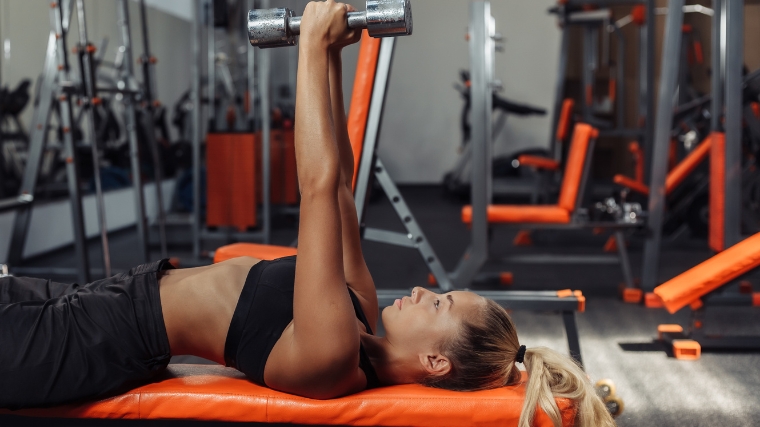
Avoid it: Anchor yourself to the bench by digging your heels into the floor and aggressively bracing your abdominal muscles.
Not Allowing the Dumbbell to “Hang”
A common mistake is to attempt to hold or orient the dumbbell horizontally during the repetition rather than vertically. This requires unnecessary action of the wrist flexors and does little to improve the pullover. At worst, this error could cause premature grip fatigue.
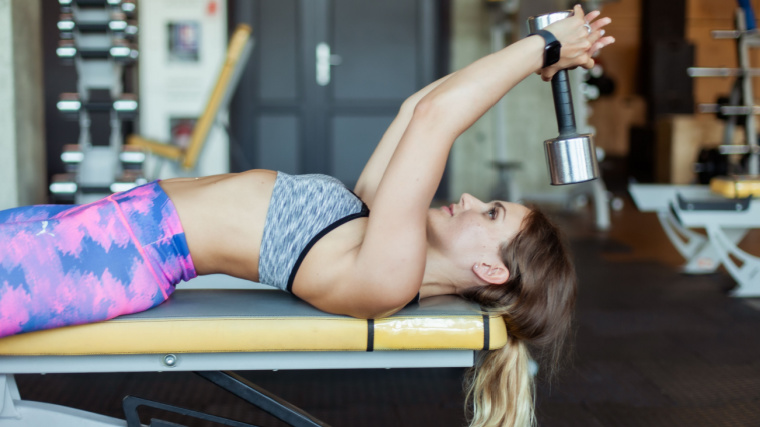
Avoid it: The dumbbell should hang naturally from your hands throughout the pullover. (1) Although you should maintain a firm grip on the dumbbell, avoid turning or tilting the dumbbell during your set.
How to Progress the Dumbbell Pullover
Lifters new to the pullover should start light when first learning the exercise. Like any exercise, the pullover must be progressed to ensure ongoing benefits. Begin by progressing traditional variables like adding reps and weight. Then, at some point, consider the simple technique modification discussed below.
Increase the Repetition Volume
As an accessory exercise, the pullover is typically programmed in the moderate repetition range (i.e. eight to 12 reps) or a higher repetition range (i.e. 12 to 16 reps). Yes, this is a broad recommendation, but it means you can likely progress for some time by adding a repetition here and there as able. Once you’re able to complete your repetition target, simply add one more rep the following workout. In the short term, progressing volume is likely most appropriate for those focused on hypertrophy. (23)
Increase the Weight
Once you reach the top of your target repetition range and feel you could do more, it is time to increase the weight of your dumbbell. Alternatively, if your primary goal is building strength, progressing weight is likely to be your best short-term strategy. (23) Since small jumps in weight dramatically increase the resistance experienced by the shoulders at the bottom of the pullover, incremental weight progression is best.
Keep Constant Tension
The dumbbell pullover traditionally begins and ends when the dumbbell is above the chest. (1) However, most of the key muscles of the pullover are offloaded at this point in the range of motion, because the dumbbell is no longer creating demand for the shoulder extensors (i.e. lats, pecs, etc.). A minor tweak to pullover technique increases the difficulty of the early portion of the movement.
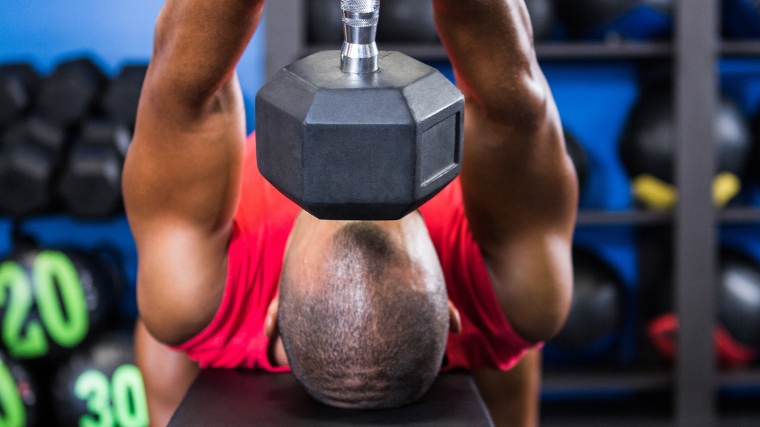
Although “constant tension” is just a catchy misnomer (no muscle experiences constant tension during dynamic exercise), we can intensify the pullover by ending the repetition and beginning the next rep while the shoulder extensors are still working. Rather than pull the dumbbell over your chest, simply reverse the movement when the dumbbell passes above your forehead.
Benefits of the Dumbbell Pullover
The dumbbell pullover trains the shoulders through an arc of overhead motion. Due to its ability to place substantial tension on already lengthened muscles, this simple exercise offers exciting benefits.
Accelerated Muscular Growth
Mechanical tension, or the end-to-end pulling force experienced by muscle tissue, is generally accepted to be a primary driver of muscle growth (hypertrophy). (3)(4) Muscles experience mechanical tension as a result of muscle contraction and stretch-induced contributions. These forces combine and, when great enough, trigger a cascade of cellular events that ultimately result in muscle growth. (3)
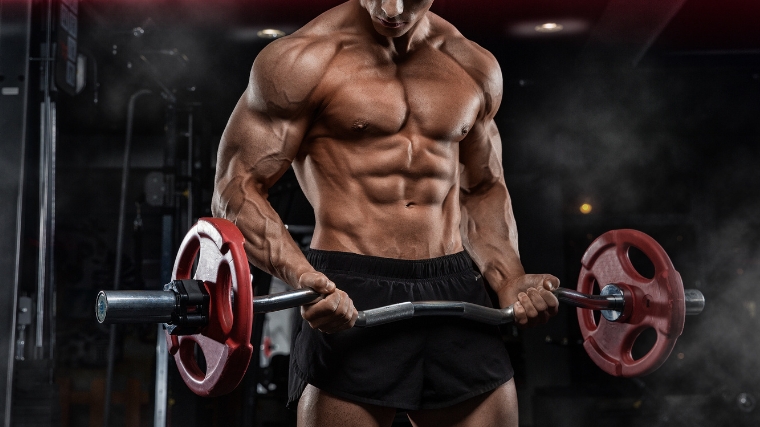
Training at long muscle lengths increases the stretch-induced contributions to mechanical tension. Growing evidence suggests that training muscles in their lengthened position results in higher rates of muscle hypertrophy. (5)(6)(7) Unfortunately, no long-term hypertrophy study to date has focused on the pullover. However, the architectural properties of latissimus dorsi and pectoralis major, two primary muscles of the pullover, suggest that training at long lengths may be particularly effective. (4)(8)
Unlike lat pulldowns, pull-ups, and chin-ups, the resistance torque of the dumbbell pullover is maximized in the overhead position. This is also the position where the average lifter’s lats and pecs are at or near their longest lengths — Altogether, the dumbbell pullover appears to impose ideal demands for “stretch-induced hypertrophy.”
Improved Flexibility
The dumbbell pullover trains the shoulder extensor muscles at long muscle lengths — in the “stretched” position. In addition to the potential hypertrophy benefits, regular resistance training is known to promote changes in muscle structure and improve flexibility. (9)(10) In the short-term, a single bout of resistance training results in immediate increases in shoulder flexion range of motion. (11) Improved shoulder flexion may be desirable, because even dedicated gym-goers can suffer from limited range of motion. For example, competitive powerlifters — those who focus primarily on the bench press, squat, and deadlift — may demonstrate substantial limitations in shoulder flexion. (12)
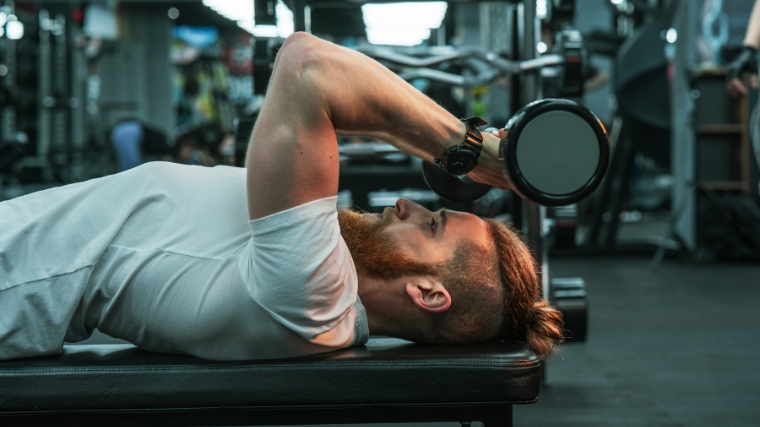
Although research on the direct effect of the dumbbell pullover on shoulder flexibility is limited, evidence is mounting to support its efficacy. Morton and colleagues compared the effects of five weeks of resistance training or static stretching on flexibility. The resistance training group completed four weekly sets of the dumbbell pullover. (10)
While both groups showed improved shoulder flexibility, the resistance training group showed a trend for superior shoulder extension gains. (10) While training durations greater than five weeks may be necessary to substantiate the effect or show statistically significant findings, it appears the dumbbell pullover is at least equivalent to stretching for shoulder flexibility.
Improved Overhead Strength and Stability
Compared to other common free weight exercises, the pullover requires your shoulders to work through a greater range of motion and results in significantly greater shoulder joint torques when similarly loaded. (13) Informed by the specificity principle, these features may result in superior strength and stability adaptations, especially through the overhead range of motion.
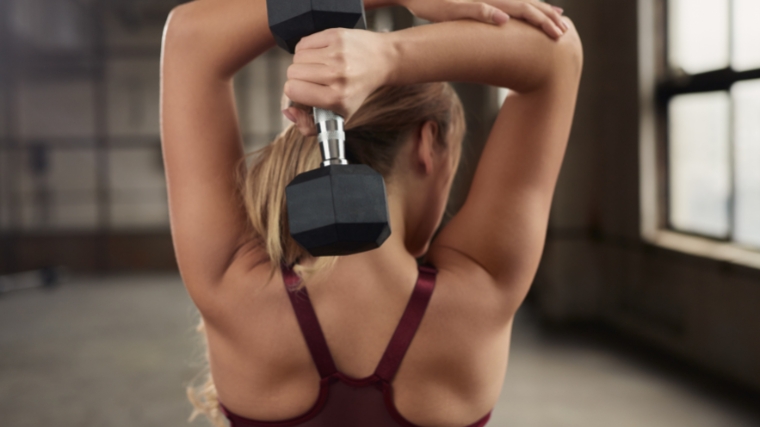
The pullover works the abdominal core along with the shoulders. Combining overhead exercise with core training is recommended for integrating strength into whole-body movements and resisting challenges to shoulder position. (14) Programmed appropriately, the pullover appears to be a strong exercise selection for targeted shoulder strengthening and robustification.
Muscles Worked by Dumbbell Pullover
The primary action resisted by the dumbbell pullover is shoulder extension. (1) Therefore, the exercise trains the muscles that extend the shoulder. Identifying these muscles may appear simple, but few exercises demonstrate the complexities of functional anatomy better than the pullover.
In basic anatomy, we learn muscle actions from “anatomical position” — a position with your arms at your sides. But the dumbbell pullover occurs through overhead range of motion, and since muscle actions may change as joints move away from anatomical position, referencing an anatomy textbook to determine the muscles that extend the shoulder worked during the pullover may be misleading. Moreover, different parts of broad or fan-shaped muscles may be biased throughout certain ranges of motion. In extreme cases, one part of a muscle may have an entirely different action than other parts of the muscle. (15)(16)
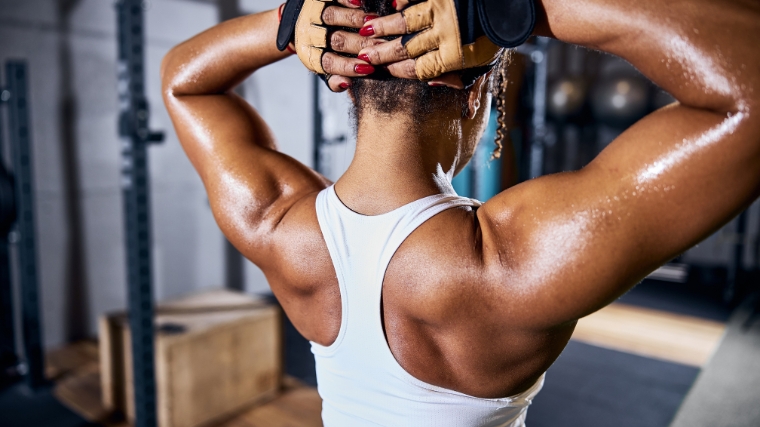
Until a long-term training study consisting exclusively of dumbbell pullovers is conducted, we lean on anatomical modeling and electromyography studies to infer the answer to the question, “What muscles are trained by the pullover?”
Latissimus Dorsi
The latissimus dorsi is a broad, fan-shaped muscle spanning from the low- and mid-back, pelvis, and back of the ribcage up to the arm. (2)(8) Latissimus dorsi is active during the Pullover. (17)(18)(19) The lower fibers, or iliac part, which attaches to the pelvis, are most effective for producing shoulder extension, the movement resisted by the pullover. (8)(16)
Pectoralis Major
Positioned prominently on the chest, the pectoralis major is another large, fan-shaped muscle. It’s commonly divided into two parts — the upper clavicular head and the middle to lower sternocostal head. Each part contributes disproportionately to various shoulder actions.
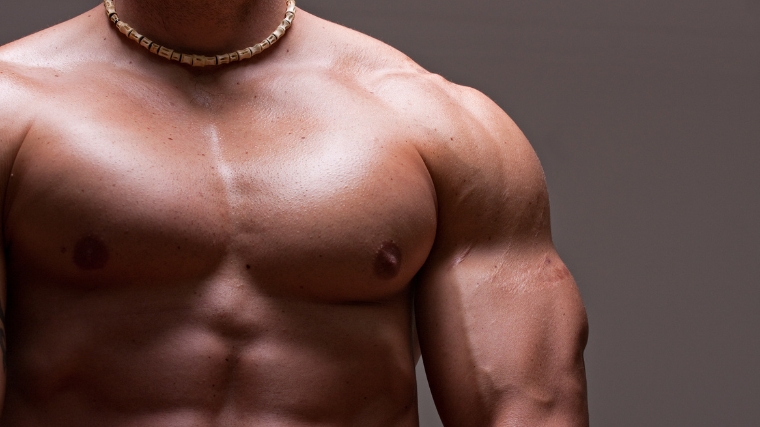
For pec training, movements like bench press, pec flye, and incline press are common. However, the sternocostal head of pectoralis major is active during the pullover. (18)(19) Available data suggest the lower fibers of pectoralis major act to extend the shoulder through the overhead range of motion. (16) Therefore, the sternocostal pectoralis major is considered a primary target of the pullover.
Posterior Deltoid
The posterior deltoid, or “rear delt,” extends the shoulder. It’s active during the pullover. (19) From a mechanical standpoint, studies suggest the posterior deltoid is a more efficient shoulder extensor during the pullover than the latissimus dorsi or pectoralis major. (15)(16) This is because posterior deltoid demonstrates more “leverage” to produce extension (i.e. a greater extension “moment arm”) throughout the arc of motion trained by the pullover. (15)(16) While the pullover might not be your first pick when it comes to posterior deltoid training, don’t underestimate its potential to build the back of your shoulders.
Triceps Brachii
The triceps brachii’s primary action is to extend the elbow. In addition, the long head of triceps brachii extends the shoulder. Ultimately, the triceps prevent excessive elbow flexion and assist with the principle movements of the pullover. The muscle controls the movement into shoulder flexion during the downward phase and extends the shoulder during the upward phase. (17)(18)(19)
Serratus Anterior and Abdominals
The serratus anterior is composed of small projections that run diagonally alongside the ribcage. It acts on the shoulder blade. The lower portion of serratus anterior has been shown to be particularly active in the bottom half of the pullover. (20)
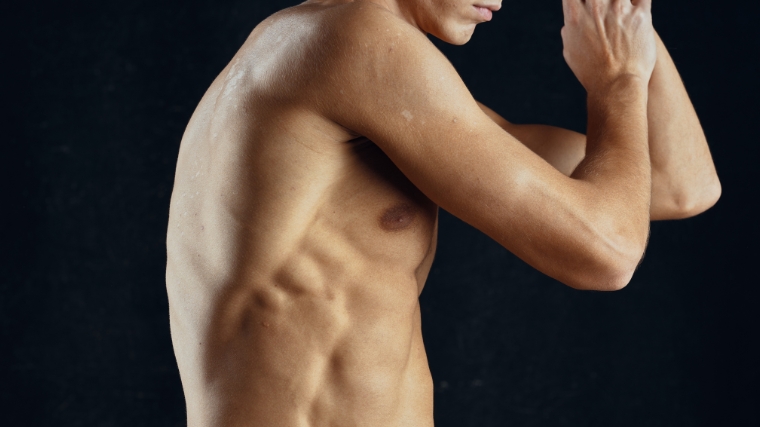
The abdominal muscles are active during the Pullover to resist excessive arching of the trunk, which would otherwise be caused by the dumbbell traveling overhead. (18) It’s fair to categorize the pullover as an anti-extension abdominal exercise.
How to Program the Dumbbell Pullover
As a single-joint movement, the dumbbell pullover is typically categorized as an accessory exercise. Traditionally, accessory exercises are performed after multi-joint (“compound”) exercises. When programming accessories, avoid extremely heavy loads and one-repetition maximum attempts. Rather, focus on multiple grueling, moderate-to-high repetition sets.
Moderate Weight, Moderate Repetitions
Those wishing to build muscle and strength with the pullover should consider three to four sets of eight to twelve repetitions. Performed after chin-ups or heavy lat pulldowns, pullovers allow you wring out a bit more hypertrophy work without taxing your grip.
Low to Moderate Weight, High Repetitions
Pullovers are a greater exercise to begin or end your upper body workout. As an opener at the beginning of your workout, pullovers prime your shoulders for subsequent overhead lifts. As a finisher to end your training session, pullovers provide a dose of “pump work” and a potent stimulus for hypertrophy. Two to four sets of twelve to sixteen repetitions will do the job.
Pullover Variations
Classic exercises tend to accumulate many variants over time, and the pullover is no different. Pullover variations tend to switch out the resistance implement (e.g. dumbbell for a barbell) or the support surface (e.g. bench for a Swiss ball). Four of the most common pullover variations are shown below.
Cross-Bench Dumbbell Pullover
The cross-bench dumbbell pullover is performed by orienting the body perpendicular to the bench and performing the exercise from a bridge position.
Not only does this setup facilitate activity of the glutes but it also encourages a stable pelvis position and allows the solo lifter to place the dumbbell conveniently on the bench before and after exercise completion.
EZ-Bar Pullover
Without access to a full run of dumbbells? Having trouble securely holding the dumbbell during the pullover? If so, you may wish to try the EZ-bar pullover.
The EZ-bar allows incremental loading with “change plates.” The semi-pronated inner grips on the bar may be easier to hold for those with stiff forearms, tight shoulders, or smaller hands.
Single-Arm Pullover
Those training for shoulder stability may wish to consider the single-arm dumbbell pullover. By training unilaterally, you’re challenging your shoulder to control movement in an additional plane.
Owing to the natural tradeoff between stability and maximum load, expect to drop the weight 60 to 80% for the single-arm dumbbell pullover.
Cable Pullover
Cable pullovers are performed with a pulley or cable column set to a low position, while holding a triceps rope, strap, or short bar. The cable pullover changes the line of the resistance. Instead of encountering maximum resistance torque at or near the bottom position as in the dumbbell pullover, the shoulders experience maximum resistance torque earlier in the movement during cable pullovers.
The cable resistance also increases the productive range of motion of the exercise. Rather than ending the repetition with vertical arms, continue “pulling over” until the cable gently grazes your forehead.
FAQs
It’s both. The pullover also hits muscles in the shoulders, arms, and trunk. (16)(17)(18)(19)(20)
If you’re using a training split, you will need to decide how to categorize the pullover. Some like to include it in “chest day,” because Pullovers hit the lower portion of pectoralis major. (16) Others put pullovers on “back day,” as it can be used to train latissimus dorsi before or after grip-intensive exercise such as rows, lat pulldowns, or pull-ups. The good news? There is no wrong answer.
The straight-arm pushdown, also called “stiff-arm pulldown” or “lat prayer,” is a shoulder extension exercise performed standing with a cable machine or high pulley. This exercise may be appealing for several reasons. There’s is no need to occupy a bench, the upright position allows you to monitor your form (and your “pump”) in the mirror, and changing weights is easier on the cable stack. But for lifters seeking hypertrophy, the crux of the question is not convenience or even the “feel” of the exercise. It comes down to inherent differences between exercise biomechanics.
The pullover and pulldown are different exercises, each with its own unique resistance profile and muscular activity pattern. (18) Anecdotally, lifters tend to “feel” their lats more during pulldowns than pullovers. The reverse seems to be true for “feeling” pectoralis major. Indeed, the pulldown shows greater muscle activity in the latissimus dorsi than the pullover, and the pullover shows greater muscle activity in all parts of pectoralis major than the pulldown. (18)
Does this mean the pullover is better for back and the pulldown is better for chest? Absolutely not. This misconception stems from a common misunderstanding of exercise electromyography (EMG) studies. Higher EMG does not equal a “better exercise,” because we cannot predict long term training outcomes from EMG studies alone. (24)(25) Moreover, EMG is not a valid indicator of mechanical tension, a key driver of muscular adaptations. (24)(3)
In short, many features must be considered when determining exercise selection. These include, but are not limited to training goals, personal preferences, and how the exercise fits into the program as a whole.
Presently, there is no definitive pullover technique modification to bias one agonist muscle over another. Although some have claimed flaring the elbows during the pullover favors latissimus dorsi and keeping elbows straight favors pectoralis major, either technique compromises the exercise.
Flaring the elbows outward results in shoulder internal rotation, which takes tension off latissimus dorsi. (26) — Not desirable if you wish to take advantage of increased tension in the muscle, stretch-mediated hypertrophy, and flexibility benefits of the exercise. (4)(8)(9)
Keeping your elbows completely straight seems to make it easier to “feel” or contract your pecs at the top of the repetition, but it also requires extreme shoulder abduction at the bottom of the repetition (think of your biceps touching your earlobes). I do not recommend either option.
The Perplexing Pullover
The pullover exercise is a conundrum. It’s performed in hardcore bodybuilding gyms and rehabilitation clinics, alike. It’s an exercise for building muscle and enhancing range of motion. It’s a back exercise and a chest exercise. It’s loved and hated.
Despite its complexities, the dumbbell pullover has stood the test of time. Maybe now is the time to focus on pullovers in your training program?
References
- Leavy, C. M. (2004). Dumbbell pullover. Strength & Conditioning Journal, 26(2), 48-49.
- Bogduk, N., Johnson, G., & Spalding, D. (1998). The morphology and biomechanics of latissimus dorsi. Clinical Biomechanics, 13(6), 377-385.
- Wackerhage, H., et al. (2019). Stimuli and sensors that initiate skeletal muscle hypertrophy following resistance exercise. Journal of Applied Physiology, 126(1), 30-43.
- Ottinger, C. R., et al. (2022). Muscle hypertrophy response to range of motion in strength training: a novel approach to understanding the findings. Strength & Conditioning Journal, 10-1519.
- Maeo, S., et al. (2021). Greater hamstrings muscle hypertrophy but similar damage protection after training at long versus short muscle lengths. Medicine and Science in Sports and Exercise, 53(4), 825.
- Maeo, S., et al. (2022). Triceps brachii hypertrophy is substantially greater after elbow extension training performed in the overhead versus neutral arm position. European Journal of Sport Science, 1-11.
- Pedrosa, G. F., et al. (2021). Partial range of motion training elicits favorable improvements in muscular adaptations when carried out at long muscle lengths. European Journal of Sport Science, 1-11.
- Gerling, M. E., & Brown, S. H. (2013). Architectural analysis and predicted functional capability of the human latissimus dorsi muscle. Journal of Anatomy, 223(2), 112-122.
- McMahon, G. E., et al. (2014). Impact of range of motion during ecologically valid resistance training protocols on muscle size, subcutaneous fat, and strength. The Journal of Strength & Conditioning Research, 28(1), 245-255.
- Morton, S. K., et al. (2011). Resistance training vs. static stretching: effects on flexibility and strength. The Journal of Strength & Conditioning Research, 25(12), 3391-3398.
- Leite, T. B., et al. (2017). Effects of different number of sets of resistance training on flexibility. International Journal of Exercise Science, 10(3), 354.
- Gadomski, S. J., Ratamess, N. A., & Cutrufello, P. T. (2018). Range of motion adaptations in powerlifters. The Journal of Strength & Conditioning Research, 32(11), 3020-3028.
- Schütz, P., et al. (2022). Chest exercises: movement and loading of shoulder, elbow and wrist joints. Sports, 10(2), 19.
- Brumitt, J., & Dale, R. B. (2009). Integrating shoulder and core exercises when rehabilitating athletes performing overhead activities. North American Journal of Sports Physical Therapy: NAJSPT, 4(3), 132-138.
- Hoffmann, M., et al. (2022). Moment arms of the deltoid, infraspinatus and teres minor muscles for movements with high range of motion: A cadaveric study. Clinical Biomechanics, 105685.
- Ackland, D. C., Pak, P., Richardson, M., & Pandy, M. G. (2008). Moment arms of the muscles crossing the anatomical shoulder. Journal of Anatomy, 213(4), 383-390.
- Borges, E., et al. (2018). Resistance training acute session: Pectoralis major, latissimus dorsi and triceps brachii electromyographic activity. Journal of Physical Education and Sport, 18(2), 648-653.
- Muyor, J. M., López-Miñarro, P. A., & Alacid, F. (2022). Comparison of electromyographic activity during barbell pullover and straight arm pulldown exercises. Applied Sciences, 12(21), 11138.
- Campos, Y. D. A. C., & Silva, S. F. D. (2014). Comparison of electromyographic activity during the bench press and barbell pullover exercises. Motriz: Revista de Educação Física, 20, 200-205.
- Büll, M. L., et al. (2001). Electromyographic validation of the trapezius and serratus anterior muscles in pull-over exercises. Brazilian Journal of Morphological Sciences, 18(1), 69-73.
- Newmire, D. E., & Willoughby, D. S. (2020). Partial Range of Motion Resistance Training: A Feasible Bodybuilding Training Regiment for Local or Regional Muscle Hypertrophy?. Strength & Conditioning Journal, 42(5), 87-93.
- dos Santos Albarello, J. C., et al. (2022). Non-uniform excitation of pectoralis major induced by changes in bench press inclination leads to uneven variations in the cross-sectional area measured by panoramic ultrasonography. Journal of Electromyography and Kinesiology, 67, 102722.
- Plotkin, D., et al. (2022). Progressive overload without progressing load? The effects of load or repetition progression on muscular adaptations. PeerJ, 10, e14142.
- Vigotsky, A. D., et al. (2018). Interpreting signal amplitudes in surface electromyography studies in sport and rehabilitation sciences. Frontiers in Physiology, 985.
- Vigotsky, A. D., et al. (2022). Longing for a longitudinal proxy: acutely measured surface EMG amplitude is not a validated predictor of muscle hypertrophy. Sports Medicine, 52(2), 193-199.
- Hik, F., & Ackland, D. C. (2019). The moment arms of the muscles spanning the glenohumeral joint: a systematic review. Journal of Anatomy, 234(1), 1-15.
Featured Image: Wavebreakmedia / Shutterstock
The post How to Do the Dumbbell Pullover for Upper Body Muscle and Mobility appeared first on Breaking Muscle.

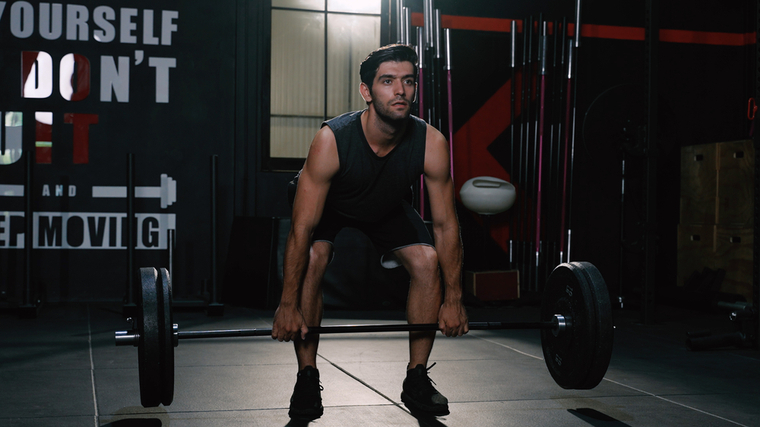
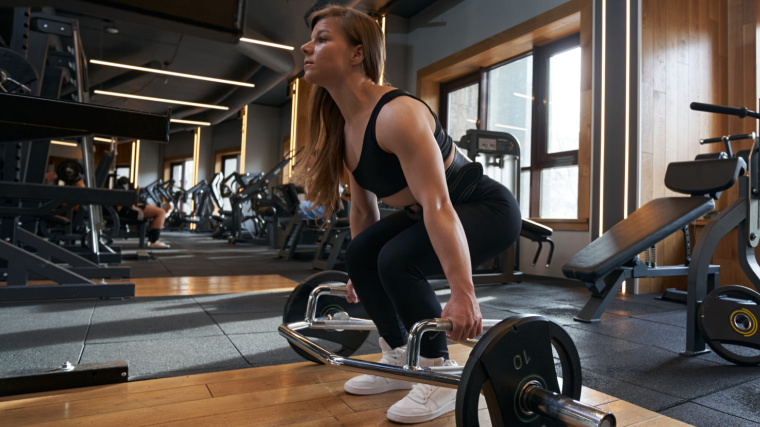
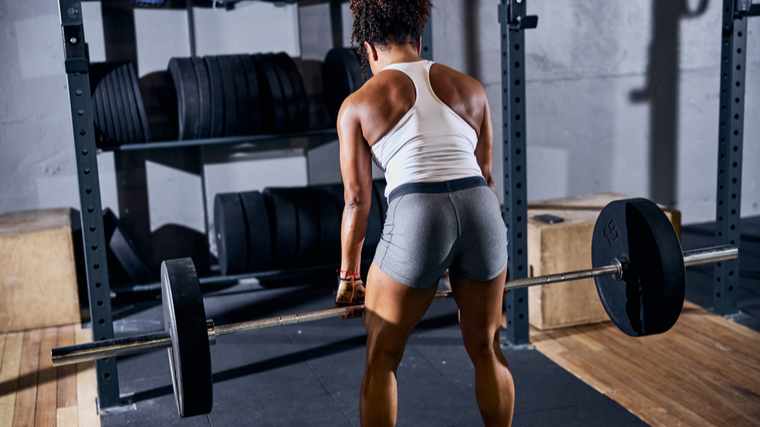
 When the keto diet first skyrocketed in popularity in the late 2010s, it quickly gained a reputation as the “bacon and butter” diet. Vegetables might appear on one’s plate as a small side of spinach or, more likely, cauliflower masquerading as everything from rice to pizza crust to
When the keto diet first skyrocketed in popularity in the late 2010s, it quickly gained a reputation as the “bacon and butter” diet. Vegetables might appear on one’s plate as a small side of spinach or, more likely, cauliflower masquerading as everything from rice to pizza crust to 


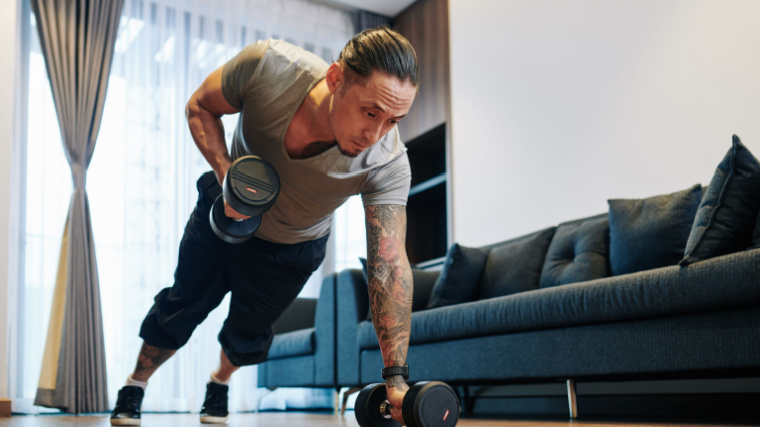
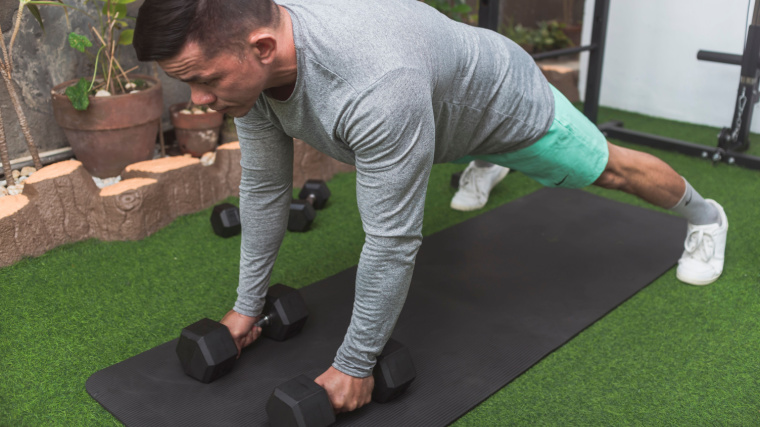
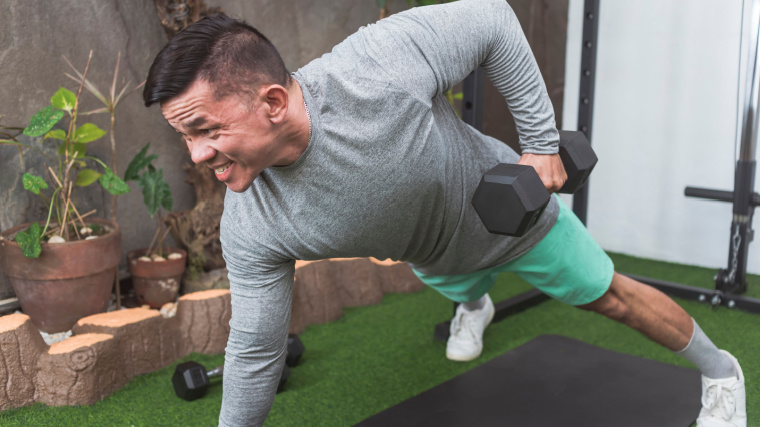
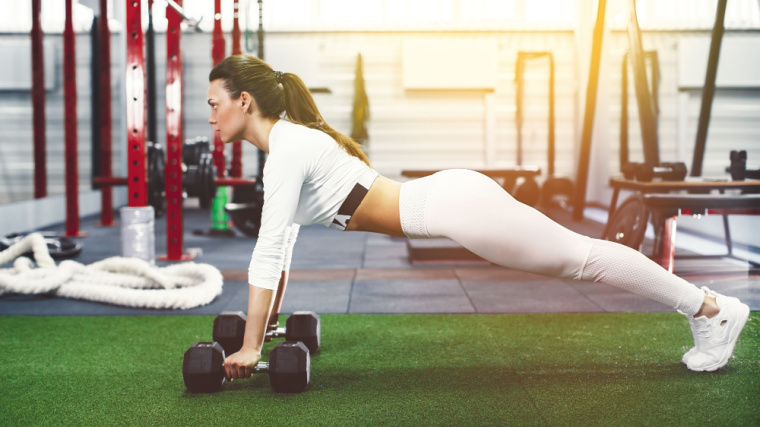
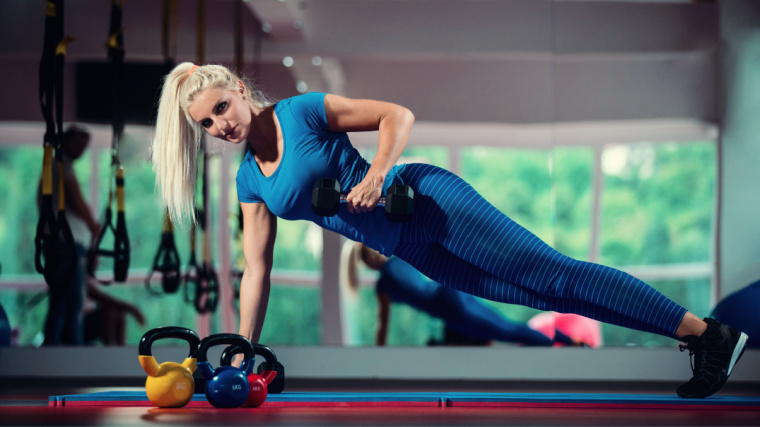
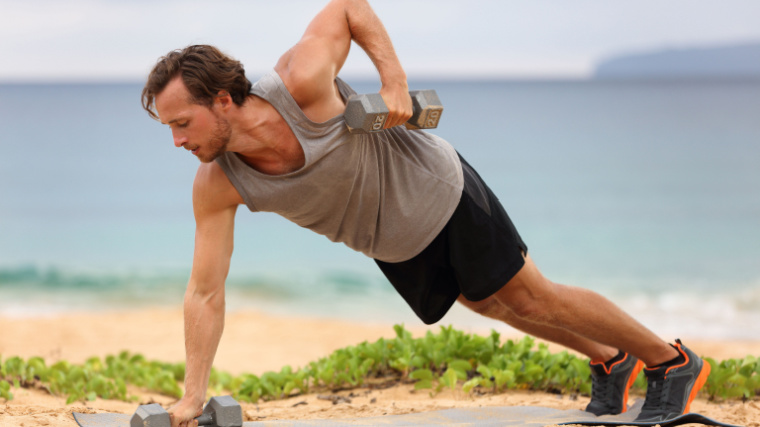
 There’s nothing more comforting than the rich tomato flavor of a classic Italian dish. However, those regularly practicing a keto lifestyle or starting a Keto Reset Diet may wonder if homestyle Italian cuisine is out of reach. This delicious keto chicken parmesan recipe proves that you don’t have to leave your comfort food favorites behind while traveling the keto path.
There’s nothing more comforting than the rich tomato flavor of a classic Italian dish. However, those regularly practicing a keto lifestyle or starting a Keto Reset Diet may wonder if homestyle Italian cuisine is out of reach. This delicious keto chicken parmesan recipe proves that you don’t have to leave your comfort food favorites behind while traveling the keto path.




 For now classes are 6pm and 640pm at 2840 Wildwood st in the Boise Cloggers studio.
Book your class NOW!
click this ==>
For now classes are 6pm and 640pm at 2840 Wildwood st in the Boise Cloggers studio.
Book your class NOW!
click this ==>








